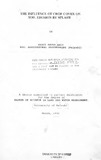| dc.description.abstract | This study involved determining the influence of crop
cover on splash erosion. This was done on 16 plots of
4 treatments of maize, beans, intercrop (maize &
beans) and bare fallow (control), with 4 replications
of each treatment.
The highest total amount of splash was recorded on
bare fallow land, followed by maize, then beans and
intercrop respectively. Soil splash per unit bare
space was found to be highest under maize, while
beans, intercrop and bare fallow had equal amounts of
splash per unit exposed surface area for a given
amount of rainfall.
The amount of soil splash per mm of rain decreased
exponentially with the percent orop cover in all the
treatments. For a given percent crop cover, soil
splash per mm of rain was constant for maize, beans
and intercrop for crop covers less than 40%. For
covers exceeding 40%, for a given amount of crop over,
splash was highest under maize, followed by beans and
intercrop respectively.
The amount of splash per mm rain also decreased
exponentially with crop height. For a given crop
height, splash per mm of rain was highest on maize,
followed by intercrop and then beans respectively.
The best erosivity factor for splash erosion in this
area was the AI45 index, defined as the product of the
rainfall amount and its maximum 45-minute intensity,
with a correlation coefficient of 0.821. Both the
total splash and the splash per exposed area increased
with each of the rainfall erosivity indices as power
functions.
The percent splash transport downslope was found to be
unrelated to either rainfall characteristics or crop
cover and height. The amount of soil splashed
downslope was about 7 times that splashed upslope on
bare fallow, and about 6 times on maize cropped plots.
For beans and intercrop, power relations existed
between upslope and downslope splash, but the overall
effect was that the ratio of splash downslope to
upslope was less than that for maize and bare fallow
plots.
The amount of soil splashed downslope decreased with
increase in crop cover for all the treatments. For a
given percent crop cover, splash downslope was highest
under maize, followed by beans and then intercrop
respectively. The amount of soil splashed upslope was
found to be unrelated to crop cover.
The amount of soil splashed both upslope and downslope
increased with the rainfall AI~ index. For a given AI~
value, splash downslope was highest on bare fallow,
followed by maize, beans and then intercrop
respectively. For a given AI45 value, soil splash
upslope was highest on bare fallow, and lowest on
maize, beans and intercrop equally.
statistical. analysis of the basic data showed that
replications were not different (a=O.Ol), and daily
splash amounts showed highly significant difference
(a=O.05). The analysis of variance tests for comparing
treatments showed thatJ all treatment pairs were
different (a=O.05) except between beans and intercrop.
The t-test for the relationships between splash amount
and crop cover or rainfall erosivity values, for
highly correlated data were all highly significant
(a=O.05) | en |

